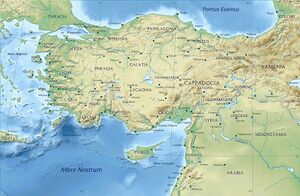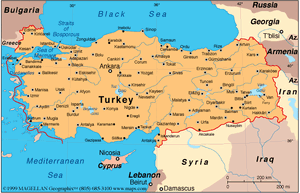Caesarea
| Author:Laxman Burdak, IFS (R) |


Caesarea , also known historically as Mazaca (Greek: Μάζακα), was an ancient city in what is now Kayseri, Turkey.
Variants
- Cæsarea (Pliny.vi.3, Pliny.vi.39)
- Caesarea /ˌsɛzəˈriːə, ˌsɛsəˈriːə, ˌsiːzəˈriːə/
- Greek: Καισάρεια,
- romanized: Kaisareia
- Mazaca (Greek: Μάζακα)
- Kayseri
Jat Gotras Namesake
- Maja = Mazaca (Greek: Μάζακα) = Caesarea (Pliny.vi.3, Pliny.vi.10, Pliny.vi.39)
- Majoka = Mazaca (Greek: Μάζακα) = Caesarea (Pliny.vi.3, Pliny.vi.10, Pliny.vi.39)
- Kecheria = Caesarea = Mazaca (Pliny.vi.3, Pliny.vi.10, Pliny.vi.39)
History
In Hellenistic and Roman times, the city was an important stop for merchants headed to Europe on the ancient Silk Road. The city was the capital of Cappadocia, and Armenian and Cappadocian kings regularly fought over control of the strategic city. The city was renowned for its bishops of both the Greek Orthodox and Armenian Apostolic faith. After the Battle of Manzikert where the Byzantine Empire lost to the incoming Seljuk Empire, the city was later taken over by the Sultanate of Rum and became reconfigured over time with the influences of both Islamic and later, Ottoman architecture.
An earlier Silk Road trading town or city can be traced to 3000 BCE, in ruined Kültepe, 20 km north-east. Findings there include numerous baked-clay tablets, some of which were enclosed in clay envelopes stamped with cylinder seals. The documents record common activities, such as trade between the Assyrian colony and the city-state of Assur and between Assyrian merchants and local people. The trade was run by families rather than the state. The Kültepe texts are the oldest documents of Anatolia. Although they are written in Old Assyrian, the Hittite loanwords and names in the texts are the oldest record of any Indo-European language[1]. Most of the archaeological evidence is typical of Anatolia rather than of Assyria, but the use of both cuneiform and the dialect is the best indication of Assyrian presence.
Caesarea remained as its precessor was a firmly inland trading centre firstly for many nearby city states, secondly due to links far beyond to east and west giving it, among regional comparators in size, enhanced trade.[2]
The city was the centre of a satrapy under Persian rule until it was conquered by Perdikkas, one of the generals of Alexander the Great when it became the seat of a transient satrapy by another of Alexander's former generals, Eumenes of Cardia. The city was subsequently passed to the Seleucid empire after the battle of Ipsus but became once again the centre of an autonomous Greater Cappadocian kingdom under Ariarathes III of Cappadocia in around 250 BC. In the ensuing period, the city came under the sway of Hellenistic influence, and was given the Greek name of Eusebia (Greek: Εὐσέβεια) in honor of the Cappadocian king Ariarathes V Eusebes Philopator of Cappadocia (163–130 BC). The new name of Caesarea (Greek: Καισάρεια), by which it has since been known, was given to it by the last Cappadocian King Archelaus [3] or perhaps by Tiberius.[4]
Roman and Byzantine rule
The city passed under formal Roman rule in 17 AD.
Caesarea was destroyed by the Sassanid king Shapur I after his victory over the Emperor Valerian I in 260 AD. At the time it was recorded to have around 40,000 inhabitants. The city gradually recovered, and became home to several early Christian saints: saints Dorothea and Theophilus the martyrs, Gregory of Nazianzus, Gregory of Nyssa and Basil of Caesarea. In the 4th century, bishop Basil established an ecclesiastic centre on the plain, about one mile to the northeast, which gradually supplanted the old town.[citation needed] It included a system of almshouses, an orphanage, old peoples' homes, and a leprosarium (leprosy hospital). The city's bishop, Thalassius, attended the[5] Second Council of Ephesus and was suspended from the Council of Chalcedon.[6]
A Notitia Episcopatuum composed during the reign of Byzantine Emperor Heraclius in about 640 lists 5 suffragan dioceses of the metropolitan see of Caesarea. A 10th-century list gives it 15 suffragans.[7] In all the Notitiae Caesarea is given the second place among the metropolitan sees of the patriarchate of Constantinople, preceded only by Constantinople itself, and its archbishops were given the title of protothronos, meaning "of the first see" (after that of Constantinople). More than 50 first-millennium archbishops of the see are known by name, and the see itself continued to be a residential see of the Eastern Orthodox Church until 1923, when by order of the Treaty of Lausanne all members of that Church (Greeks) were deported from what is now Turkey.[8] Caesarea was also the seat of an Armenian diocese.[9] No longer a residential bishopric, Caesarea in Cappadocia is today listed by the Catholic Church as a titular see of the Armenian Catholic Church and the Melkite Catholic Church.[10] It was a titular see of the Roman Church under various names as well, including Caesarea Ponti.
A portion of Basil's new city was surrounded with strong walls, and it was turned into a fortress by Justinian. Caesarea in the 9th century became a Byzantine administrative centre as the capital of the Byzantine Theme of Charsianon. The 1500-year-old Kayseri Castle, built initially by the Byzantines, and expanded by the Seljuks and Ottomans, is still standing in good condition in the central square of the city.
Home to many early Christian saints,[11] such as Basil, Andreas (Andrew) and Emmelia of Caesarea. It was an important trading centre[12]on the Silk Road.
Successor city
The city has some surviving buildings and is otherwise largely the foundations of what is now Kayseri, Turkey.[13]
Mention by Pliny
Pliny[14] mentions....In its (Cappadocia) remaining districts there is Melita,8 founded by Semiramis, and not far from the Euphrates, Diocæsarea,9 Tyana,10 Castabala,11 Magnopolis,12 Zela,13 and at the foot of Mount Argæus14 Mazaca, now called Cæsarea.15
8 Which gave name to the district of Melitene, mentioned in c. 20 of the last Book.
9 Near Nazianzus, in Cappadocia, the birth-place of Gregory Nazianzen. The traveller Ainsworth, on his road from Ak Serai to Kara Hissar, came to a place called Kaisar Koi, and he has remarked that by its name and position it might be identified with Diocæsarea. Some geographers, indeed, look upon Diocæsarea and Nazianzus as the same place.
10 Its ruins are still to be seen at Kiz Hisar. It stood in the south of Cappadocia, at the northern foot of Mount Taurus. Tyana was the native place of Apollonius, the supposed worker of miracles, whom the enemies of Christianity have not scrupled to place on a par with Jesus Christ.
11 Some ruins, nineteen geographical miles from Ayas, are supposed to denote the site of ancient Castabala or Castabulum.
12 This place was first called Eupatoria, but not the same which Mithridates united with a part of Amisus. D'Anville supposes that the modern town of Tchenikeb occupies its site.
13 Or Ziela, now known as Zillah, not far south of Amasia. It was here that Julius Cæsar conquered Pharnaces, on the occasion on which he wrote his dispatch to Rome, "Veni, vidi, vici."
14 Still known by the name of Ardgeh-Dagh.
15 Its site is still called Kaisiriyeh. It was a city of the district Cilicia, in Cappadocia, at the base of the mountain Argæus. It was first called Mazaca, and after that, Eusebeia. There are considerable remains of the ancient city.
Mention by Pliny
Pliny[15] mentions The Rivers Cyrus and Araxes....The more famous towns in Lesser Armenia are Cæsarea3, Aza4, and Nicopolis5; in the Greater Arsamosata6, which lies near the Euphrates, Carcathiocerta7 upon the Tigris, Tigranocerta8 which stands on an elevated site, and, on a plain adjoining the river Araxes, Artaxata.9
3 Hardouin thinks that this is Neo-Cæsarea, mentioned as having been built on the banks of the Euphrates.
4 Now called Ezaz, according to D'Anville. Parisot suggests that it ought to be Gaza or Gazaca, probably a colony of Median Gaza, now Tauris.
5 Originally called Tephrice. It stood on the river Lycus, and not far from the sources of the Halys, having been founded by Pompey, where he gained his first victory over Mithridates, whence its name, the "City of Victory." The modern Enderez or Devrigni, probably marks its site.
6 Ritter places it in Sophene, the modern Kharpat, and considers that it may be represented by the modern Sert, the Tigranocerta of D'Anville.
7 The capital of Sophene, one of the districts of Armenia. St. Martin thinks that this was the ancient heathen name of the city of Martyropolis, but Ritter shows that such cannot be the case. It was called by the Syrians Kortbest; its present name is Kharput.
8 Generally supposed, by D'Anville and other modern geographers, to be represented by the ruins seen at Sert. It was the later capital of Armenia, built by Tigranes.
9 The ancient capital of Armenia. Hannibal, who took refuge at the court of Artaxias when Antiochus was no longer able to afford him protection, superintended the building of it. Some ruins, called Takt Tiridate, or Throne of Tiridates, near the junction of the Aras and the Zengue, were formerly supposed to represent Artaxata, but Colonel Monteith has fixed the site at a bend in the river lower down, at the bottom of which were the ruins of a bridge of Greek or Roman architecture.
References
- ↑ Watkins, Calvert. "Hittite". In: The Ancient Languages of Asia Minor. Edited by Roger D. Woodard. Cambridge University Press. 2008. p. 6. ISBN 978-0-511-39353-2
- ↑ Borges, Jason (2020-02-18). "Caesarea Mazaca (Kayseri)". Cappadocia History.
- ↑ Everett-Heath, John (2005). Kayseri. Concise Dictionary of World Place-Names. Oxford University Press.
- ↑ https://www.newadvent.org/cathen/03133b.htm
- ↑ Richard Price, Michael Gaddis The Acts of the Council of Chalcedon, Volume 1 p31.
- ↑ Richard Price, Michael Gaddis, The Acts of the Council of Chalcedon, Volume 1 p36.
- ↑ Heinrich Gelzer, Ungedruckte und ungenügend veröffentlichte Texte der Notitiae episcopatuum, in: Abhandlungen der philosophisch-historische classe der bayerische Akademie der Wissenschaften, 1901, p. 536, nº 77–82, and pp. 551–552, nnº 106–121.
- ↑ Pius Bonifacius Gams, Series episcoporum Ecclesiae Catholicae Archived 2015-03-08 at Wikiwix, Leipzig 1931, p. 440
- ↑ "Caesarea". Catholic Encyclopedia. Archived
- ↑ Annuario Pontificio 2013 (Libreria Editrice Vaticana 2013 ISBN 978-88-209-9070-1), p. 867
- ↑ "Cappadocian Saints - Discover Cappadocia". www.discovercappadocia.com.
- ↑ Borges, Jason (2020-02-18). "Caesarea Mazaca (Kayseri)". Cappadocia History.
- ↑ Borges, Jason (2020-02-18). "Caesarea Mazaca (Kayseri)". Cappadocia History.
- ↑ Natural History by Pliny Book VI/Chapter 3
- ↑ Natural History by Pliny Book VI/Chapter 10
Back to Jat Places in Turkey

